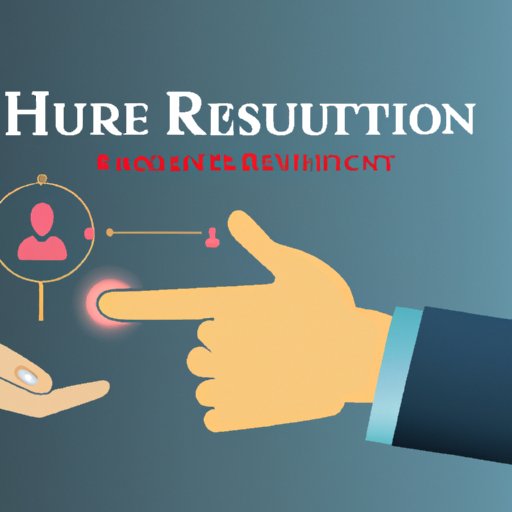Introduction
In today’s competitive job market, organizations are constantly looking for ways to optimize their talent acquisition processes. As a result, it is important to understand the relationship between talent acquisition and human resources (HR). To begin, let’s first define each of these terms.
Talent acquisition refers to the process of identifying, attracting, and hiring qualified individuals for an organization. It includes activities such as job postings, interviewing, and onboarding.
Human resources (HR) is a broad term that encompasses all aspects of employee relations, from recruitment and selection to training and development. It is essentially the management of people within an organization.
Now that we have defined these two terms, let’s take a look at the relationship between them.

Exploring the Relationship Between Talent Acquisition and Human Resources
At first glance, talent acquisition and HR may appear to be similar. After all, they both involve recruiting and managing employees. However, there are some key differences between the two.
What is the Difference Between Talent Acquisition and Human Resources?
The primary difference between talent acquisition and HR is the scope of their operations. Talent acquisition focuses solely on the recruitment and hiring of new employees, whereas HR covers the entire employee lifecycle from recruitment to retirement. This means that HR has a much broader scope than talent acquisition.
Another key difference is the approach taken by each. Talent acquisition is typically focused on short-term objectives, such as filling positions quickly and efficiently. On the other hand, HR takes a more long-term approach, focusing on strategies such as employee retention and engagement.
Is Talent Acquisition a Sub-Function of Human Resources?
The answer to this question is both yes and no. While talent acquisition is certainly a part of HR, it is not the only component. Other aspects of HR include employee relations, compensation and benefits, training and development, and performance management. Talent acquisition is just one piece of the puzzle.
The Role of Talent Acquisition in Organizational Success
Organizations must have effective talent acquisition processes in place in order to remain competitive. Without talented and motivated employees, businesses will struggle to succeed. Therefore, it is important to understand how talent acquisition can contribute to organizational success.
Strategies for Optimizing Talent Acquisition Practices
There are several strategies organizations can use to optimize their talent acquisition practices. These include developing a strong employer brand, leveraging social media platforms to attract top talent, and using data-driven decision making. Additionally, organizations should focus on creating a positive candidate experience throughout the recruitment process.
Best Practices for Combining Talent Acquisition with Human Resources
When it comes to combining talent acquisition with HR, it is important to ensure that the two functions are aligned. This means having a shared vision, common goals, and clear communication between departments. Additionally, HR should provide support and guidance to the talent acquisition team in order to ensure that their efforts are successful.

How Technology is Changing the Talent Acquisition Process
Technology is playing an increasingly important role in the talent acquisition process. Automation is being used to streamline the recruitment process, which can help organizations save time and money. Additionally, organizations are utilizing analytics to gain insights into applicant behavior and make more informed hiring decisions.
Use of Automation in Talent Acquisition
Automation is becoming increasingly popular in the talent acquisition space. Automated tools can be used to post jobs, screen resumes, and conduct interviews. This allows organizations to reduce the amount of time and effort required to hire new employees.
Benefits of Utilizing Technology in the Talent Acquisition Process
Utilizing technology in the talent acquisition process can help organizations make better hiring decisions and improve their overall recruiting strategy. Additionally, technology can help organizations identify potential candidates faster and more effectively, allowing them to fill positions in a shorter timeframe.
Conclusion
Talent acquisition and human resources are two distinct yet related fields. While talent acquisition is primarily focused on the recruitment and hiring of new employees, HR covers the entire employee lifecycle from recruitment to retirement. Additionally, technology is changing the way organizations recruit, with automation and analytics playing an increasingly important role in the talent acquisition process.
In conclusion, it is important for organizations to understand the relationship between talent acquisition and HR in order to optimize their recruitment efforts. By aligning the two functions and utilizing technology, organizations can ensure that they are able to attract, hire, and retain the best talent.
Summary of Main Points
This article explored the relationship between talent acquisition and human resources, discussing their differences, role in organizational success, and how technology is changing the talent acquisition process. The main points discussed included the scope of each field, strategies for optimizing talent acquisition practices, best practices for combining talent acquisition with HR, and the use of automation and analytics in the talent acquisition process.
Recommendations for Further Research
Further research could be conducted to explore the impact of technology on the talent acquisition process and how organizations can best utilize it. Additionally, research could be conducted to identify best practices for integrating talent acquisition with HR, as well as strategies for improving the candidate experience.
(Note: Is this article not meeting your expectations? Do you have knowledge or insights to share? Unlock new opportunities and expand your reach by joining our authors team. Click Registration to join us and share your expertise with our readers.)
